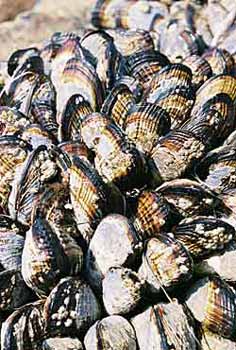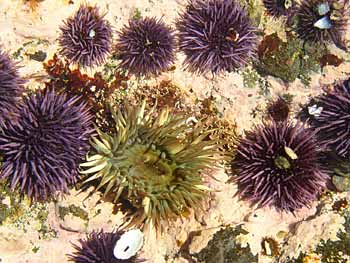|
INVENTORY OF ROCKY INTERTIDAL
RESOURCES IN SOUTHERN SANTA
BARBARA, VENTURA AND LOS ANGELES COUNTIES
Principal Investigator:
Richard Ambrose
(UCLA)
Project Summary
 The southern California coast possesses an exceptional
diversity of valuable rocky intertidal resources. In addition,
these rocky intertidal resources are heavily utilized, with large human
populations concentrated on the coastlines of San Diego, Orange and Los
Angeles Counties. Knowledge of the status and trends in rocky
intertidal resources over a wide region is essential for understanding
how oil and gas development might affect these important
resources. Oil and gas activities, especially the tankering of
oil along the California coast, raise the possibility of an oil spill
or other impact to coastal resources. Population monitoring of
coastal biota can provide indispensable information on the effects of
an oil spill as already demonstrated for the recent spill at Vandenburg
AFB. This research project continues a long-term monitoring
study begun 10 years ago. This baseline information is essential
for (1) scientific studies investigating the short- and long-term
effects of an oil spill, and (2) natural resource damage
assessment. In addition, the monitoring studies will yield
important data on population dynamics on a local and regional scale,
which could be utilized for more effective resource management as well
as provide fundamental ecological knowledge about the dynamics of the
systems. The southern California coast possesses an exceptional
diversity of valuable rocky intertidal resources. In addition,
these rocky intertidal resources are heavily utilized, with large human
populations concentrated on the coastlines of San Diego, Orange and Los
Angeles Counties. Knowledge of the status and trends in rocky
intertidal resources over a wide region is essential for understanding
how oil and gas development might affect these important
resources. Oil and gas activities, especially the tankering of
oil along the California coast, raise the possibility of an oil spill
or other impact to coastal resources. Population monitoring of
coastal biota can provide indispensable information on the effects of
an oil spill as already demonstrated for the recent spill at Vandenburg
AFB. This research project continues a long-term monitoring
study begun 10 years ago. This baseline information is essential
for (1) scientific studies investigating the short- and long-term
effects of an oil spill, and (2) natural resource damage
assessment. In addition, the monitoring studies will yield
important data on population dynamics on a local and regional scale,
which could be utilized for more effective resource management as well
as provide fundamental ecological knowledge about the dynamics of the
systems.
Major factors contributing to the richness of coastal
marine life in central and southern California include their location
along the boundary of two major biogeographic provinces (cold-temperate
Oregonian and warm-temperate California), their high diversity of
habitat types, and their exposure to varying local oceanographic
conditions. In addition, these rocky intertidal resources are
heavily utilized, with large human populations concentrated on the
coastlines of San Diego, Orange and Los Angeles Counties.
Significant activities related to the production of oil and gas occur
along this same stretch of coastline, and offshore extraction,
transport of oil and decommissioning of platforms may lead to oil
spills or other impacts to coastal resources. Monitoring of
coastal biota in central and southern California provides baseline
information in case an event such as a spill damages these
resources. This baseline information is essential for effective
resource management or understanding anthropogenic effects (such as an
oil spill), as well as provide fundamental ecological knowledge about
the dynamics of the system.
 This study addresses the need to continue the inventory
of the coastal ecological resources of southern Santa Barbara, Ventura
and Los Angeles Counties. (inventories are also being done in San
Luis Obispo, northern Santa Barbara, and Orange Counties). In
2005, the inventory will be entering its 15th year. During this
period, it has been funded by MMS, CMI, the California Coastal
Commission and the County of Santa Barbara. All of these agencies
recognized the value of the inventory as the primary source of
information for determining the impacts of (mainly) oil spills.
Indeed the 1997 oil spill at Vandenburg Air Force Base in northern SB
County reinforces the contention that such disturbances are inevitable
and that long-term baseline information is essential for determining
their biological impacts. For that spill, the only source of
baseline information that could be used to assess damages to biological
communities came from our shoreline inventory. Moreover, we were
able to estimate the biologic effect of the spill only because our
sampling program has been running long enough to determine the sort of
biological changes resulting from natural disturbances like ENSO
events. Only long term and ongoing inventories allow such
separation of natural from anthropogenic disturbances. This study addresses the need to continue the inventory
of the coastal ecological resources of southern Santa Barbara, Ventura
and Los Angeles Counties. (inventories are also being done in San
Luis Obispo, northern Santa Barbara, and Orange Counties). In
2005, the inventory will be entering its 15th year. During this
period, it has been funded by MMS, CMI, the California Coastal
Commission and the County of Santa Barbara. All of these agencies
recognized the value of the inventory as the primary source of
information for determining the impacts of (mainly) oil spills.
Indeed the 1997 oil spill at Vandenburg Air Force Base in northern SB
County reinforces the contention that such disturbances are inevitable
and that long-term baseline information is essential for determining
their biological impacts. For that spill, the only source of
baseline information that could be used to assess damages to biological
communities came from our shoreline inventory. Moreover, we were
able to estimate the biologic effect of the spill only because our
sampling program has been running long enough to determine the sort of
biological changes resulting from natural disturbances like ENSO
events. Only long term and ongoing inventories allow such
separation of natural from anthropogenic disturbances.
Summarized results for selected
species are available to the public at:
www.marine.gov
|
[homepage]
|
[overview]
|
[researchers]
| [students
& staff]
|
[research] | [download
reports]
|
|

